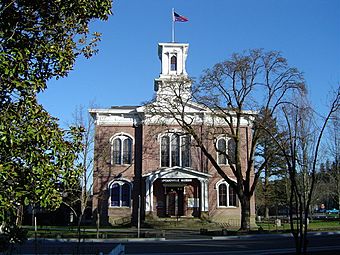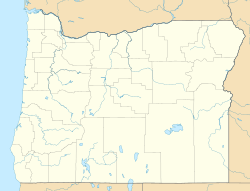Jacksonville Historic District (Jacksonville, Oregon) facts for kids
|
Jacksonville Historic District
|
|

Jacksonville Museum, the former Jackson County Courthouse.
|
|
| Location | Jacksonville, Oregon |
|---|---|
| Area | 326 acres (132 ha) |
| Built | 1853 |
| Architectural style | Greek Revival, Italian Villa, Gothic Revival |
| NRHP reference No. | 66000950 |
Quick facts for kids Significant dates |
|
| Added to NRHP | November 13, 1966 |
| Designated NHLD | November 13, 1966 |
The Jacksonville Historic District is a special area in Jacksonville, Oregon. It protects the old part of this town, which was once a busy mining center in the 1800s. From 1852 to 1884, Jacksonville was a very important place for mining, government, and business.
After that, the town became quieter. This means many of its old buildings from that time are still standing. They show what architecture was like back then. This collection of old buildings is unique in the Pacific Northwest region. Because it's so special, the district was named a U.S. National Historic Landmark in 1966.
Contents
Jacksonville's Gold Rush History
The town of Jacksonville started in 1852. This happened after people found gold in the nearby hills. The town grew very quickly in its first year.
How the Town Grew and Changed
In 1853, Jacksonville became the main town for Jackson County. This meant it was the "county seat," where the local government was located. It also became the most important place for money and business in the gold mining areas of southwestern Oregon. The town did very well until the 1870s.
In 1873, a big fire destroyed a large part of Jacksonville. Even though much of it was rebuilt, the town's importance started to fade. This was especially true when the railroad was built and bypassed Jacksonville. This meant trains didn't stop there. Later, in 1927, the county government moved to Medford. This made Jacksonville even less central.
Exploring the Historic District Today
The historic district includes the town's main shopping area. This is found on East California Street. It also stretches north into the old neighborhoods where people lived.
The old county courthouse is now a museum. It belongs to the local historical society. This museum helps people learn about Jacksonville's past.
Old Buildings and Styles
The buildings in the district show many different styles. These styles were popular between the 1850s and 1880s. You can see buildings in the Greek Revival, Italianate, and Gothic Revival styles.
One very well-preserved building is the Beekman Bank, built in 1856. It still has all the original items from when it was a bank. The district also includes the town's first cemetery, which was started in 1860.



